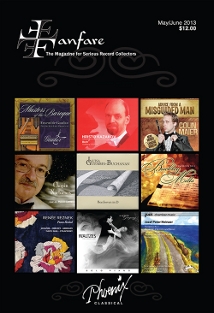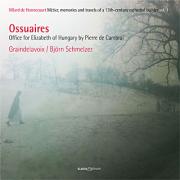Texte paru dans: / Appeared in:

Fanfare Magazine: 36:5 (05-06/2013)
Pour
s'abonner / Subscription information
Les abonnés à Fanfare Magazine ont accès aux archives du
magazine sur internet.
Subscribers to Fanfare Magazine have access to the archives of the magazine
on the net.
Glossa
GCDP32107

Code-barres / Barcode : 8424562321076
Consultez toutes les évaluations recensées pour ce cd
~~~~ Reach all the evaluations located for this CD
A rare example of duplicating a rhymed office on disc, this Office of St. Elizabeth of Hungary can be compared with Schola Hungarica’s offering (Fanfare 19:4), which had not only this Cambrai version of the Office but also the Central European version for Marburg and Hungary. (It was not unusual for a saint to be commemorated with several late medieval liturgical offices; Andrew Hughes’s catalog often lists two to five or more Offices for one saint). Elizabeth, the daughter of King Andrew II of Hungary, married the future margrave of Thuringia at the age of 14 after being reared by his family. He died on crusade in the Holy Land, and the young widow, the mother of three children, left her life of luxury to serve the sick and poor at Marburg, dying in 1231 at the age of 23. Beloved by the common people of Hungary and Germany for her humility and service, she was canonized in 1235. Devotion at Cambrai was occasioned by a gift from her to the cathedral; Pierre de Cambrai set chant melodies to texts by Gérard de Saint-Quentin.
Schola Hungarica sang much of the Cambrai Office, including antiphons and responsories of Matins, the initial antiphon from First Vespers (“Gaudeat Hungaria”), a hymn, and the two-voice motet on “Decantatur.” Schmelzer duplicates “Gaudeat Hungaria,” four of the responsories, and the motet, while adding one unfamiliar piece that links France and Hungary, though it is not related to Elizabeth. This last is a lament of the Blessed Virgin in Magyar, a contrafact of the Parisian lament “Planctus ante nescia.” The disc is full because each of the responsories is over 10 minutes long. I’ve found this ensemble interesting on previous acquaintance, but this time they are rather hard to take. Their style is greatly reminiscent of Marcel Pérès, with a lot of drones, peculiar rhythms, and slo-o-ow tempos.
This is the first of three CDs that will provide the soundtrack for a film about Villard de Honnecourt (13th century), who went to Hungary to design a tomb for Elizabeth’s mother, which prompted in return Elizabeth’s gift to Cambrai cathedral. Villard’s European travels are illustrated by his surviving architectural drawings. Schmelzer sees a link between the architecture and the music of the time. The notes are a little sketchy about all this, and Barbara Haggh’s notes on the Hungaroton disc actually add some information about Villard.
Schmelzer’s first five discs can be found by referring to “Cesena” (35:6). After refreshing my memory, it’s apparent that my enthusiasm for his first four discs has cooled off considerably with the two latest. His less-desirable traits seem to be coming to the fore, obscuring the very real intellect behind all of these programs. Maybe you should hear for yourself. I hope to sum up when the other two discs appear and the rationale becomes clearer.
Cliquez l'un ou l'autre
bouton pour découvrir bien d'autres critiques de CD
Click either button for many other reviews


